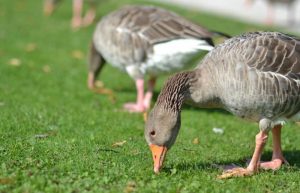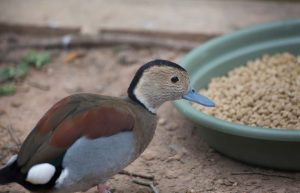
What You Need to Know About Ducks Having Teeth
Ducks are omnivorous creatures, which means they consume everything from aquatic plants to small fish and water snails, depending on their individual breed and the habitat they live in. But, how do ducks eat their food? Do they have a set of teeth that enables them to chew their food?
Do ducks have teeth? No, ducks do not have teeth like humans. Instead, like all other species of waterfowl, ducks have a set of lamellae. These are tiny notches within a duck’s beak that help position chunks of food within a duck’s bill. The pieces of food are then swallowed whole instead of being broken up by the duck’s mouth.
Now that you know that ducks do not have a set of teeth akin to human teeth, you may have more questions about how they consume their food. For this article, I’m going to take an in-depth look at how ducks eat, digest, and “chew” their food and how individual duck breed diets can affect the digestion process. Let’s get into it!
What are Duck Teeth Called?
Though ducks don’t have teeth, per se, they do have a set of lamellae on the inside of their bills. The lamellae are tiny rivets within the duck’s bill that are only visible when they open their mouth. While human teeth are made of bone, the lamellae are made of the same keratin that makes up the duck’s bill.
The lamellae in a duck’s mouth can be compared to the baleen in a whale’s mouth. Lamellae help to filter out water, mud, and other debris that a duck may have picked up while eating. It also helps the duck position food in its mouth before swallowing the food whole.
How Do Ducks Eat?
Ducks eat a variety of plants and small animals, like fish and snails. Without teeth, you may be wondering how ducks break up their food for adequate digestion. Well, the duck digestive system is complex and different from that of a human. There is very little outside preparation to ready a duck’s food for consumption. It goes like this:
What Does a Duck’s Bill Do?
 The bill is considered the mouth of the duck. Duckbills come in all shapes and sizes, depending on the specific breed and habitat of the duck. The top and bottom of a bill come together to form a mechanism that functions similarly to a set of chopsticks, capturing and crushing food through the pressure of their bill.
The bill is considered the mouth of the duck. Duckbills come in all shapes and sizes, depending on the specific breed and habitat of the duck. The top and bottom of a bill come together to form a mechanism that functions similarly to a set of chopsticks, capturing and crushing food through the pressure of their bill.
Depending on the duck breed, bill shape and size can vary drastically from one duck to another. Duck breeds with a flatter bill, such as the mallard duck, tend to consume more plant material than duck breeds with sharper bills, like the Merganser duck. These ducks have very small, sharp bills that assist them in consuming small fish and other prey. Their bill shape is critical in providing them with natural hunting abilities that support their more carnivorous diets.
The nail is a point at the tip of a duck’s bill. This is useful for separating food from other materials, such as mud and dirt. The nail helps the duck in foraging food items, predominantly when a duck’s diet consists of primarily aquatic plants that can be caked in silt from the lake or river bottom.
Once again, the nail of a duck can differ broadly according to the specific breed of the duck. The Muscovy Duck, for example, has a very pronounced nail that resembles a large pimple at the tip of its bill. This is because the Muscovy Duck typically eats plant materials found in shallow water, which are covered in dirt and mud from the bottom of a lake or swamp bed. The nail is more prominent on this specific type of duck because it benefits them more about their habitats and diets.
What Does a Duck’s Lamellae Do?
After a duck uses its bill and nail to sift through the mud for something tasty to eat, the food goes straight into the mouth and, subsequently, the lamellae. The lamellae, contrary to popular belief, does not crush up the food in any way. Instead, it helps to position the food item within the duck’s mouth for a safe swallow.
Yes, you read that right; ducks swallow their food whole. This may seem very counter-intuitive to some, but it makes sense when examined in the context of a duck’s digestive system. During swallowing, a duck’s tongue helps to push the food down into the esophagus.
What Does a Duck’s Esophagus Do?
A duck’s esophagus functions much like a human’s. In case you’re not familiar with this body part and its function, let’s review:
A duck’s esophagus is the pathway for moving food down the throat and through the digestive system. The only difference between a duck’s esophagus and a human’s esophagus is that a duck’s esophagus can also function as a mini-storage space for extra food. This part of the esophagus is called the crop, and it’s a widened area in the esophagus that foragers can store extra food for later.
Glandular Stomachs in Ducks
After food slides down the duck’s esophagus, it enters the final part of the upper digestive system: the glandular stomach. The glandular stomach does not fully digest food, but it does secrete enzymes that soften the food to help it break down more effectively.
Fun fact: the upper digestive system of a duck is typically where biologists who study duck diets obtain food samples, as the food is not entirely unrecognizable at this stage in the process.
What Does a Duck’s Gizzard Do?
This is probably the most fun part of a duck’s digestive system because the gizzard is like the duck’s teeth! You may be familiar with the delicacy of duck or chicken gizzard, often served in fine restaurants, and wonder how such a delicious organ…chews up food!
The gizzard is a small, meaty organ that contains particles of sand, stone, and grit to grind up a duck’s dinner and prepare it for digestion. It functions through pure pressure and force, pulverizing the food for consumption.
Interestingly enough, the gizzard can change size to account for what a duck is consuming. A larger gizzard is more efficient when it comes to processing larger foods, like small fish and mollusks. On the other hand, a smaller gizzard is all that’s required when processing aquatic plants and foliage.
Now that you’re familiar, maybe too familiar, with the way ducks eat and process food, let’s move on to another important question concerning duck teeth and duck diets.
What Do Ducks Eat?
Duck diets can vary dramatically depending on their environment and breed. That being said, ducks are considered omnivores. This means they’ll eat both plants and small animals, as well as insects and small fish. Certain duck breeds will rely more heavily on vegetation in their diets while others will have a largely carnivorous diet.
Can Ducks Bite?
Ducks are typically docile creatures unless they feel stressed or threatened by other ducks, animals, or humans. In these cases, will a duck bite?
Yes, a duck will bite a human if it feels threatened by them. Like every other animal, Ducks use biting as a way to defend themselves against predators or to protect their babies. Typically, female ducks attack only when they feel their eggs, nest, or babies are being threatened by an outside force.
On the other hand, Male ducks tend to bite if they feel their territory is threatened or to establish dominance. If you’re curious about the warning signs that a duck may bite or you want to learn more about why ducks bite, check out my article Do Ducks Bite? Everything You Need to Know.
Do Duck Bites Hurt?
Due to their lack of teeth, duck bites cannot break the skin as easily as a dog bite or a cat bite. Instead, they can cause bruising and swelling if the pressure is great enough. The lack of teeth means that the pain of a duck bite comes from the intense pressure that the duck can place via its bill. Therefore, pain can depend on how upset a duck is, which can affect how hard they chomp down on your extremities.
Most of the time, duck bites are accidental and occur during feeding sessions. For example: you may place your hand out in front of a duck with food and they nibble your finger by accident. These little nibbles will most likely not hurt; but instead, feel uncomfortable or simply shock you from surprise. The most you might feel from an accidental bite is a sharp pinch, but you should be alright without any teeth to break the skin.
If you’re planning on getting a flock of ducks, understanding their needs and abilities can help you better prepare to care for them. To learn more about one consideration when it comes to owning ducks, check out my article Can Ducks Fly? Ultimate Duck Flight Guide.
